Related Research Articles

The Standard Works of the Church of Jesus Christ of Latter-day Saints are the four books that currently constitute its open scriptural canon. The four books of the standard works are:

"The Family: A Proclamation to the World" is a 1995 statement issued by the Church of Jesus Christ of Latter-day Saints which defined the official position of the church on family, marriage, gender roles, and human sexuality. It was first announced by church president Gordon B. Hinckley.
Among many churches in the Latter Day Saint movement, the First Presidency is the highest presiding or governing body. Present-day denominations of the movement led by a First Presidency include the Church of Jesus Christ of Latter-day Saints, the Community of Christ, Remnant Church of Jesus Christ of Latter Day Saints, and the Righteous Branch of the Church of Jesus Christ of Latter-Day Saints.
In the Latter Day Saint movement, the President of the Church is generally considered to be the highest office of the church. It was the office held by Joseph Smith, founder of the movement, and the office assumed by many of Smith's claimed successors, such as Brigham Young, Joseph Smith III, Sidney Rigdon, and James Strang. Several other titles have been associated with this office, including First Elder of the church, Presiding High Priest, President of the High Priesthood, Trustee-in-Trust for the church, Prophet, Seer, Revelator, and Translator. Joseph Smith was known by all of these titles in his lifetime.
A stake is an administrative unit composed of multiple congregations in certain denominations of the Latter Day Saint movement. The name "stake" derives from the Book of Isaiah: "enlarge the place of thy tent; stretch forth the curtains of thine habitation; spare not, lengthen thy cords, and strengthen thy stakes". A stake is sometimes referred to as a stake of Zion.
A general authority is a member of the highest levels of leadership within the Church of Jesus Christ of Latter-day Saints who has administrative and ecclesiastical authority over the church. A general authority's jurisdiction is church-wide, in contrast to the responsibilities of a local authority or an area authority, which relate to a particular area, unit, or department of the church. As a group, the general authorities are often referred to as "the Brethren". As of April 2023, The LDS listed 95 general authorities.

In the Latter Day Saint movement, a general conference is a meeting for all members of the church for conducting general church business and instruction. When Joseph Smith established the Church of Christ in 1830, he was instructed by revelation that the church "are to meet in conference once in three months, or from time to time as said conferences shall direct or appoint; And said conferences are to do whatever church business is necessary to be done at the time." The church met in conferences regularly until Smith's death in 1844.
In the Latter Day Saint movement, patriarch is an office of the priesthood. It is considered to be either an office of the patriarchal priesthood or the Melchizedek priesthood.

The 1890 Manifesto is a statement which officially advised against any future plural marriage in the Church of Jesus Christ of Latter-day Saints. Issued by Church President Wilford Woodruff in September 1890, the Manifesto was a response to mounting anti-polygamy pressure from the United States Congress, which by 1890 had disincorporated the church, escheated its assets to the U.S. federal government, and imprisoned many prominent polygamist Mormons. Upon its issuance, the LDS Church in conference accepted Woodruff's Manifesto as "authoritative and binding."

The succession crisis in the Latter Day Saint movement occurred after the killing of the movement's founder, Joseph Smith, on June 27, 1844.
Elder is a priesthood office in the Melchizedek priesthood of denominations within the Latter Day Saint movement, including The Church of Jesus Christ of Latter-day Saints.
In the Church of Jesus Christ of Latter-day Saints, a church membership council is an ecclesiastical event during which a church member's status is considered, typically for alleged violations of church standards. If a church member is found to have committed an offense by a membership council, they may have their name removed from church records, or their church membership may be otherwise restricted. Church membership councils are at times referred to unofficially as church courts.
Worship services of the Church of Jesus Christ of Latter-day Saints include weekly services held in meetinghouses on Sundays in geographically based religious units. Once per month, this weekly service is a fast and testimony meeting. Twice each year, the LDS Church holds a worldwide general conference. LDS Church adherents also worship in temples, which are open only to members in good standing.
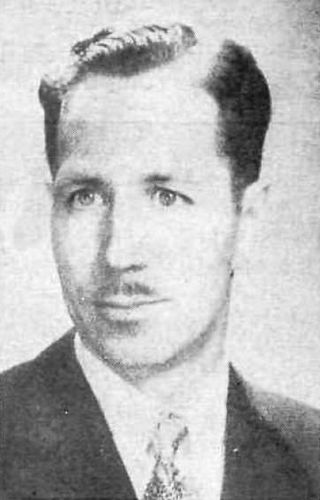
Eldred Gee Smith was the patriarch to the church of the Church of Jesus Christ of Latter-day Saints from 1947 to 1979. From 1979 to his death he was the patriarch emeritus of the church. He was the oldest and longest-serving general authority in the history of the church, although he had not been active in that capacity from 1979 to his death.
The Presiding Bishop of the Church of Jesus Christ of Latter-day Saints is a priesthood calling with church-wide authority. The Presiding Bishop is the highest leadership position within the church's Aaronic priesthood, although most of the work in this area is delegated to the church's Young Men general presidency.
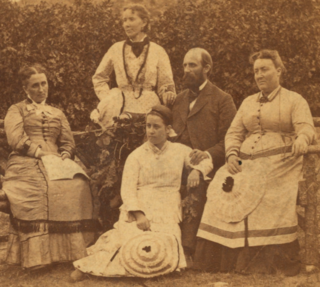
The "Second Manifesto" was a 1904 declaration made by Joseph F. Smith, the president of the Church of Jesus Christ of Latter-day Saints, in which Smith stated the church was no longer sanctioning marriages that violated the laws of the land and set down the principle that those entering into or solemnizing polygamous marriages would be excommunicated from the church.
A solemn assembly is a formal and sacred procedure in the Church of Jesus Christ of Latter-day Saints conducted to give added emphasis to the purpose of the occasion. Solemn assemblies are held at the dedications of temples and for specially-called meetings to provide instruction to church leaders. Solemn assemblies are also held for the purpose of sustaining a new church president, who church members consider to be a prophet, seer, and revelator. Such assemblies are held, in particular, to follow the law of common consent.
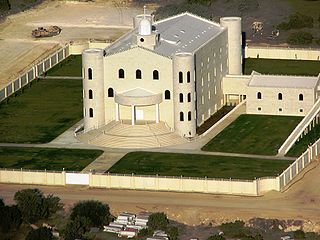
The term placement marriage refers to arranged marriages between members of the Fundamentalist Church of Jesus Christ of Latter-Day Saints. Placement marriage is believed and practiced by members of the FLDS Church to show their commitment and obedience in order to obtain salvation for themselves and their parents; it might be considered “the most visible outward symbol of members’ devotion."
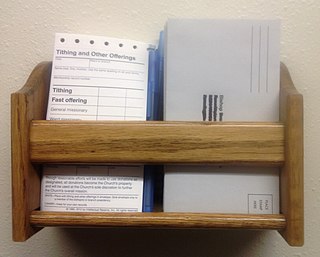
Tithing is a commandment accepted by various churches in the Latter Day Saint movement. In practicing tithing, adherents make willing tithe donations, usually ten percent of their income, to their church. It is based on both the biblical practice of paying tithes and modern revelation given to Joseph Smith and his accepted successors. For many of these churches, the law of tithing replaced or supplemented the law of consecration. The Church of Jesus Christ of Latter-day Saints emphasized tithing in the 1900s and 1960s to assist in paying church debts.
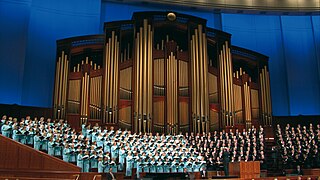
General Conference is a gathering of members of the Church of Jesus Christ of Latter-day Saints, held biannually every April and October at the Conference Center in Salt Lake City, Utah. During each conference, church members gather in a series of two-hour sessions to listen to the faith's leaders.
References
- ↑ D&C 28:13
- ↑ The only one authorized to bring forth new doctrine is the President of the Church, who, when he does, will declare it as revelation from God, and it will be accepted by the church's First Presidency and Quorum of the Twelve Apostles, and then sustained by the body of the church. (Harold B. Lee, The First Area General Conference for Germany, Austria, the Netherlands, Italy, Switzerland, France, Belgium, and Spain of The Church of Jesus Christ of Latter-day Saints, held in Munich Germany, August 24–26, 1973, with Reports and Discourses, 69. OCLC 59671066 ASIN B0017RUZQE.)